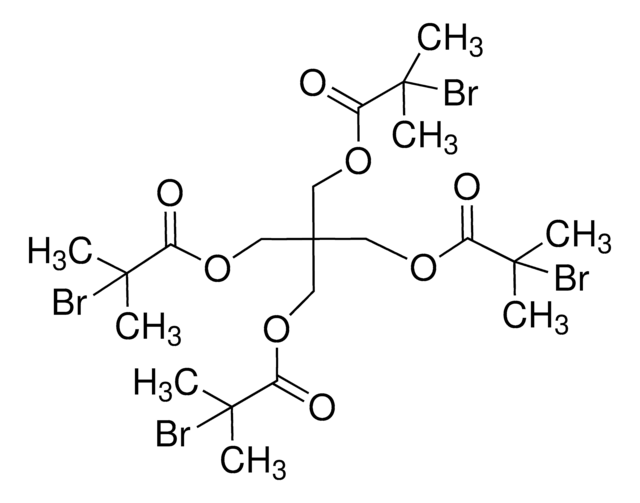419214
Dimethyl 2,6-dibromoheptanedioate
97%
Synonym(s):
2,6-Dibromoheptanedioic acid dimethyl ester
About This Item
Recommended Products
Assay
97%
form
liquid
greener alternative product score
old score: 2
new score: 1
Find out more about DOZN™ Scoring
greener alternative product characteristics
Waste Prevention
Safer Solvents and Auxiliaries
Design for Energy Efficiency
Learn more about the Principles of Green Chemistry.
sustainability
Greener Alternative Product
refractive index
n20/D 1.501 (lit.)
bp
130-140 °C/0.01 mmHg (lit.)
density
1.59 g/mL at 25 °C (lit.)
greener alternative category
SMILES string
COC(=O)C(Br)CCCC(Br)C(=O)OC
InChI
1S/C9H14Br2O4/c1-14-8(12)6(10)4-3-5-7(11)9(13)15-2/h6-7H,3-5H2,1-2H3
InChI key
AWWJYEJSCIDADZ-UHFFFAOYSA-N
Related Categories
General description
Application
- Preparation of difunctional poly(n-butyl acrylate) (pBA) macroinitiator.
- As initiator for the synthesis of dibromo-terminated polystyrene, via atom transfer radical polymerization (ATRP).
- Preparation of polytrithiocarbonate, which serves as Reversible Addition-Fragmentation chain Transfer (RAFT) agent for radical polymerization reactions.
Signal Word
Warning
Hazard Statements
Precautionary Statements
Hazard Classifications
Acute Tox. 4 Oral - Eye Irrit. 2 - Skin Irrit. 2 - STOT SE 3
Target Organs
Respiratory system
Storage Class Code
10 - Combustible liquids
WGK
WGK 3
Flash Point(F)
235.4 °F - closed cup
Flash Point(C)
113 °C - closed cup
Personal Protective Equipment
Certificates of Analysis (COA)
Search for Certificates of Analysis (COA) by entering the products Lot/Batch Number. Lot and Batch Numbers can be found on a product’s label following the words ‘Lot’ or ‘Batch’.
Already Own This Product?
Find documentation for the products that you have recently purchased in the Document Library.
Customers Also Viewed
Our team of scientists has experience in all areas of research including Life Science, Material Science, Chemical Synthesis, Chromatography, Analytical and many others.
Contact Technical Service




![Tris[2-(dimethylamino)ethyl]amine 97%](/deepweb/assets/sigmaaldrich/product/structures/695/792/ee0ff167-22a3-43a7-83a1-6c4908adf0ae/640/ee0ff167-22a3-43a7-83a1-6c4908adf0ae.png)







![4-Cyano-4-[(dodecylsulfanylthiocarbonyl)sulfanyl]pentanol](/deepweb/assets/sigmaaldrich/product/structures/839/520/64c23004-f340-460f-a379-8670a35d0433/640/64c23004-f340-460f-a379-8670a35d0433.png)


